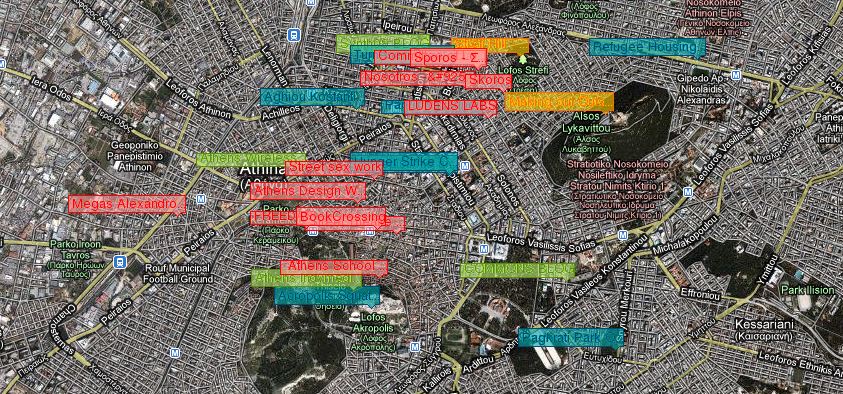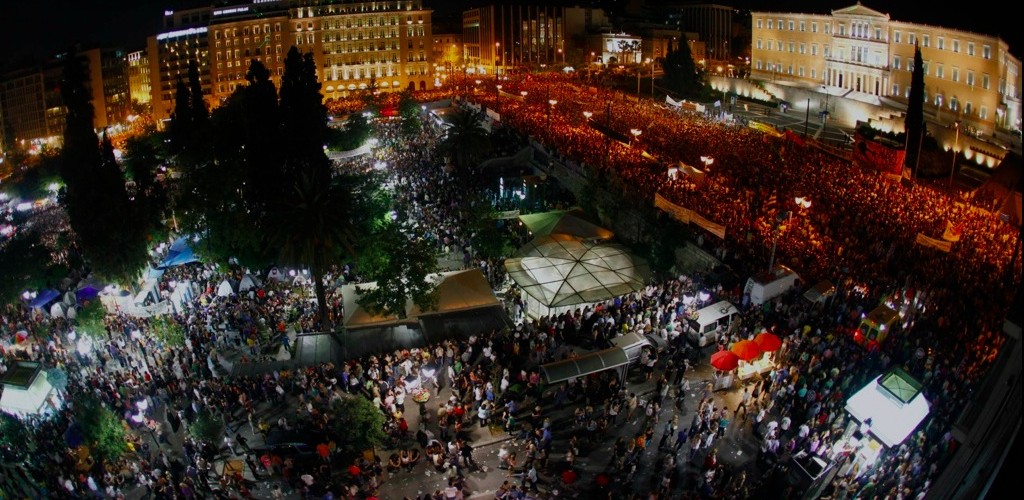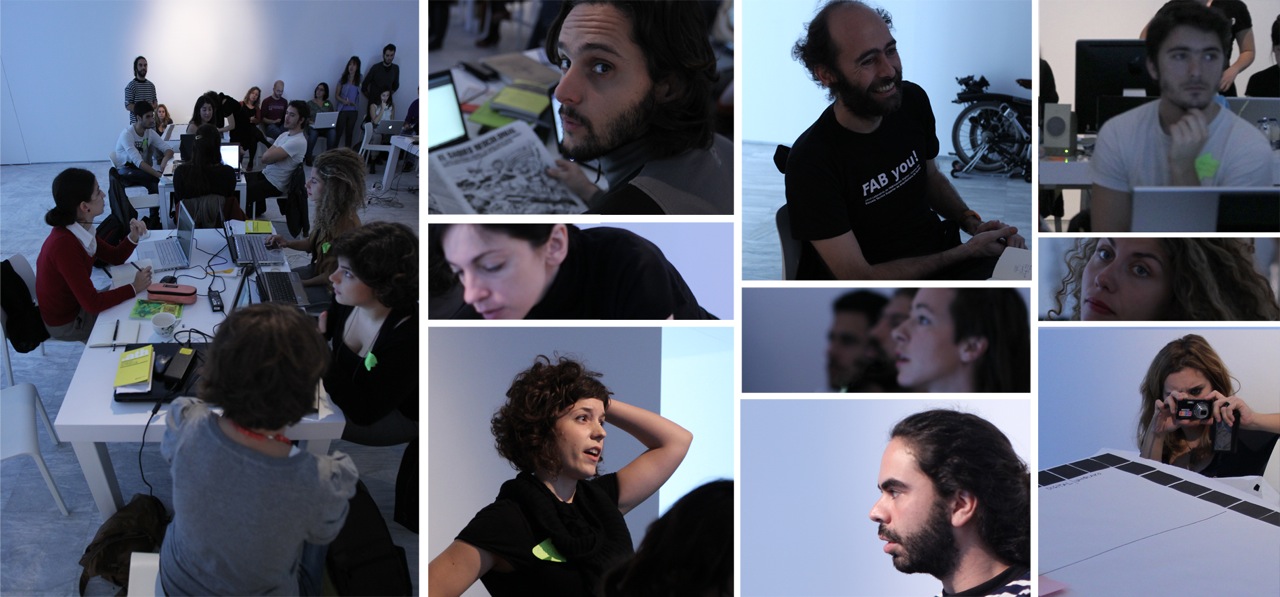Mapping the Commons of Athens[1] took place at the end of 2010, at the year when Greece started losing its financial independence. Six months after the first memorandum with IMF and the implementation of the first austerity measures, the Greek capital was called upon to play a new role. Athens was invited to become the “beta” city of crisis, to constitute the experimental ground for the emerging transitional economic period and to confront first in Europe the impasse of late capitalism. The metropolis looked vulnerable but also restless, and its territory was the one where older and newer forms of resistance and counter-practices were about to be formed but also challenged.
Inspired by the thought of Hardt and Negri, the workshop ‘Mapping the Commons, Athens’ aimed to study and empower these emerging forms of resistance, by focusing on the city’s most significant wealth, its commons.[2] If “the city is the source of the common and the receptable into which it flows” as the philosophers argue, then a cartography of the commons for the city of Athens, a city in times of crisis, would be able to highlight the city’s living dynamic and its possibility for change. With this goal in mind, the team was faced with an interesting but difficult challenge; to emphasize the wealth of the metropolis by turning to the affects, languages, social relationships, knowledge and interests of its multitude; to build a cartography based on commons that to a great extent were immaterial and abundant, fluid and unstable and to therefore try to respond to certain difficult questions: How can the new artificial commons be mapped? Do they emerge in times of crisis? Do they constitute a form of resistance and which are the new dangers of enclosure that need to be faced?
After discussions and meetings with people from different areas working on the commons, the participants of the workshop in collaboration with the team of Hackitectura proceeded first to the documentation of the urban commons as part of a research online map and then to the making of short video case studies, as part of an interactive video cartography presenting representative commons found in the city . Seeing beyond the “public” and the “private”, this collective effort aimed to offer to the inhabitants of Athens a new useful tool and a different reading for their city. The types of commons that were mapped are based on collectivity, sociability and sharing; they are encouraging open and free access and peer to peer practices. The database is rich and wide varying from squatted and self-managed parks in the heart of the city to digital platforms for the sharing and upcycling of objects; from anger and its expression on the streets[3] to the thousand wireless network nodes open in the city, from the critical mass of cyclists demanding roads for people not cars to the language as main common, from the free software and P2P[4] to the parties demanding the ludic use of the streets, from the animals as fellow humans[5] to graffiti as common artistic expression on the city walls . The workshop also produced a blog documenting the progress of work and an installation hosted at the National Museum of Contemporary Art after the completion of the work.
Language like affects and gestures, is for the most part common, and indeed if language were made either private or public — that is, if large portions of our words, phrases, or parts of speech were subject to private ownership or public authority — than language would lose its powers of expression, creativity, and communication. M. Hardt, A. Negri, Commonwealth
Two years later, the maps produced are still on view online and remain open to further contributions by anyone interested. Seen by their creators as databases of exchange, the hope was and still is to inform the inhabitants about spaces where communities of commoners are formed and to empower the city’s ground for social encounters and experiences. Built as a result of a truly “common” effort, they were based on the belief that the exit from impasse of the crisis can possibly be found through creativity that embraces the ideas of sharing and co-producing.

http://meipi.org/mappingthecommons
Notes:
[1] Athens Workshop credits:
Concept and project development: José Pérez de Lama de Lama & Pablo de Soto (Hackitectura) in collaboration with Jaime Díez and Carla Boserman, With the support of cartografiaciudadana.net
Curated by: Daphne Dragona
Participants: Efi Avrami, Elena Antonopoulou, Mariana Bisti, Maya Bontzou, Dimitris Delinikolas, Eleni Giannari, Aliki Gkika, Anastasia Gravani, Alexis Hatzigianis, Dimitris Hatzopoulos, Melina Flippou, Zaharias Ioannidis, Angela Kouveli, Veroniki Korakidou, Daphne Lada, Olga Lafazani, Natalie Michailidou, Yiannis Orfanos, Stratis Papastratis, Maria Dimitra Papoulia, Yorgos Pasisis, Carolin Philipp, Maria Pitsiladi, Manos Saratsis, Athina Staurides, Iouliani Theona, Eleana Tsoukia, Sonia Tzimopoulou, Antonis Tzortzis, Dimitris Psychogios
Scientific Advisors: Nelli Kabouri (Political Sciences, Panteion University), Dimitris Papalexopoulos (Architect, Associate Professor NTUA), Dimitris Parsanoglou (Sociologist, Panteion University), Dimitris Charitos (Assistant Professor, Department of Communication and Mass Media, University of Athens)
The work Mapping the Commons, Athens was realized in the framework of the series EMST Commissions 2010 at the Project Room of the museum, with the kind support of Bombay Sapphire gin. See http://www.emst.gr/mappingthecommons/index.html
[2] Michael Hardt and Antonio Negri, Commonwealth, Cambridge, MA, The Belknap Press of Harvard University Press, 2009.
[3] The topic of Anger as a Common is presented by Matthias Fritsch in his video as: “Can anger be a common? Like care and love can be considered commons. In the Athens of riots, the Athens after December 2008, anger and rage brought part of the multitude together for better or for worse. Whose side are you on? Do you know what comes next?”
[4] Free information and media exchange as commons. Intellectual property forms a primary means for enclosing common knowledge production. Through IP, knowledge is commodified and then transmitted through controlled means of distribution. P2P file sharing is a practice through which knowledge production and its distribution channels are re-appropriated for the commons.
[5] Can the stray animals also constitute a city’s commons? Prior to 2004, Athens was a common space for animals and humans.There were many cats and dogs that lived all around the city without human masters or liberated from relations of bondage. Stray animals and humans often lived in a relationship of companionship, offering to each other communication, food, shelter, affection and protection.
Supported by:

COMMON: Free education
University protests take place in order to protect the common of public education. The entry of entrepreneurial rules in education degrades the role of the university as a free research center. Students and professors through assemblies decide their actions which include practices like universities squats and manifestations. The School of Architecture in particular had organized a happening in Syntagma square in order to inform the people of this major common being in state.
COMMON: Anger
Can anger be a common? Like care and love can be considered commons. In the Athens of riots, the Athens after December 2008, anger and rage brought part of the multitude together for better or for worse. Whose side are you on? Do you know what comes next?
COMMON: Public transportation
Since 2008, the unified ticket for all the means of public transport [bus, metro, tube, tram line] was implemented also in Athens. After validating a ticket passengers are able to travel within the entire transportation network, additionally having the option to change means within one and a half hour. Yet this convenient measure was combined with an increase of the ticket value. Only a few days after the operation of this new way of moving in the city thousands of e-mails were sent and received so as to induce people to leave their ‘used’ tickets [the ones which are still valid for some time] next to the validation machines or in other spots accessible by other passengers, who would not have to buy a new ticket. Ticket crossing is considered to be an illegal action…
COMMON: Free information and media exchange
Intellectual property forms a primary means for enclosing common knowledge production. Through IP, knowledge is commodified and then transmitted through controlled means of distribution. P2p file sharing is a practice through which knowledge production and its distribution channels are re-appropriated for the commons.
COMMON: Fair and small scale production of goods
The commons are not free of commercialization. Through the production of the commons, though, social relations between consumers and producers can be transformed in a mutually beneficial and non hierarchical manner. There are many different ways in which commercial and anti-commercial practices are being juxtaposed in the commons:
COMMON: Street Party
WHAT STREET PARTY? is an open, Athens-based, guerilla, non-profit, wiki collective. The collective is interested into Guerilla street-parties as an action of public space reclaiming, reunion, expression, creation, communication, experimentation, music vibration, body vitalization. During these parties, a big dancing crowd establishes a route in the city, stops in predefined spots and interacts with the citizens in an effort to regain the city space.
COMMON: Urban Safety
The brutal murder of December 6th 2008 caused an unprecedented explosion of rage. Two years later, the streets of Athens became a common platform of expression for thousands of citizens.
COMMON: Streffi Hill
Strefi hill is located in Exarchia and belongs to the municipality of Athens. Once it was called Anchesmos and was private property of a family with the name Strefi. For a lot of years, during 19th and 20th century, a quarry was operating on the hill. Since it closed down, trees were planted in the area and in 1963 the Strefi family decided to donate the hill to the municipality of Athens. Currently there is a small open air theatre, a basketball court, a playground and two small canteens on the hill. The place is used for recreation, gatherings and open free cultural events. The trees and greenery and also the several spots from which one can enjoy views of the city, also make the place worth a visit. The residents of Exarchia take care of the hill by organising cleaning shifts since the municipality does not contribute a lot to the maintenance of the place.
COMMON: Quality of urban life
The constantly uprising problems of the metropolis, in connection with the inability of local authorities to manage the emerging issues on the local scale, contribute to the creation of self-organized multitudes. Those are constituted of multiple singularities, formulating claims, which are common among all the members, regardless, any political or personal beliefs. The major venture is the lack of open- public spaces.
COMMON: In between spaces
Can be considered every area where two different environments collide, two different situations. The in-between is a border which tends to be an area, an interface of action where its contents react, penetrate each other giving birth to a space of transformation and interaction, tends to become a common space by its use. The typical examples of in-between spaces in Athens are 1.The arcade of the greek polykatoikia a space between the public and the private, common space and the opposite 2.The void akalyptos inside a building square. It is an in between space as something totally common and private.
COMMON: Transnational spaces
These days are ours, too is a text-event that captures the Commons that Athens became for a short period of time during the December revolts of 2008. It was written by a group of Albanian migrants who argued that the spontaneous involvement in the uprising challenged many long lasting practices of racism and exclusion.
English text: http://www.occupiedlondon.org/blog/2008/12/15/these-days-are-ours-too/
COMMON: Animals living freely
Animals and humans as companions. Prior to 2004, Athens was a common space for animals and humans.There were many stray animals that lived all around the city without human masters or liberated from relations of bondage. Stray animals and humans often lived in a relationship of companionship, offering to each other communication, food, shelter, affection and protection.
COMMON: Free software
Α large community of users and developers who work for continuous improvement of Free Libre Open Source Software FLOSS (software that anyone can freely use, copy, distribute and modify according to their needs)sharing knowledge and work. The commonity contributes thus to the production and the expansion of the commons.
COMMON: Cycling friendly city
In a city that offers priority to the automobile, a group of citizens shares a common goal: to introduce the bicycle in the Athenians.
COMMON: Exterior surfaces as communication
Graffiti is an activity that potentially redefines the uses and character of private or public exterior surfaces. Through the practice of graffiti walls, trains, buses, derelicts, public signs lose their private or public character and constitute an open, common canvas for the production of visual works.
COMMON: Wireless metropolitan network
Started in 2002 in Athens Greece, Athens Wireless Metropolitan Network (AWMN) is a grassroots wireless community, taking advantage of new, state of the art wireless technologies, to connect people and services. The network is comprised of 1120 backbone nodes (as of Aug, 2010) and more than 2900 client computers connect to it. More than 9,000 people have stated their intention to join AWMN in the near future.[1] There is also an association-club named awmn.
COMMON: Memory
http://www.youtube.com/watch?v=F-wrrrtDoWQ
Time marks common space. Collective memory is a common. A cartography of past commons exists in parallel with present and future commons. Past experiences and events shape the ways in which we move in the city and invest certain spots with symbolic meanings.>> The video ” common memory ” is based on short interviews regarding the memories of the revolt at December 2008 in Athens and what people expect now from the future. Realisation and editing Maya Bontzou 2010.
COMMON: Navarinou Park
http://www.youtube.com/watch?v=UDXRpAspGDk
The Navarinou Park, also known as the parking park is a free self-managed space in Exarcheia – an area which is a centre of social movements and alternative cultural practices since the 1970s. The ground actually belongs to TEE, which first was to host its offices, later it was to become a square as part of an exchange with the Municipality of Athens, and finally it turned out to become an open air parking space since 1990. In 2008 the lease was terminated and the issue of its construction was raised provoking reactions by local groups. On the 7th of March 2009 a multitude of people (including groups and individuals) responded to a digital call for collective action and occupied the space demanding the transformation of the parking into a park. Guerilla gardening started right away. The park has become a self-organised, anti-hierarchical and anti-commercial space with an open assembly. The park is actually a place of gathering, creation, emancipation, gaming and resistance. It aims to become a park beyond profit and property, functioning as a space of play,assembly and communication, creativity, exchange and activism beyond barriers of age, origin, education, social and financial status.
COMMON: Freecycle
Freecycle group is a web – based group, open to all who want to donate or request objects for free. It works locally at a global level (each city in every country forms a new individual network). Against the perpetual procedure of consuming and disposal, which results in aggregation of several tons of used materials, the group suggests donation and recycling.
COMMON: Language
Language like affects and gestures, is for the most part common, and indeed if language were made either private or public — that is, if large portions of our words, phrases, or parts of speech were subject to private ownership or public authority — than language would lose its powers of expression, creativity, and communication. M. Hardt, A. Negri, Commonwealth
Credits:
Concept, workshop and project development:
José Pérez de Lama and Pablo de Soto (Hackitectura) in collaboration with Jaime Díez and Carla Boserman
With the support of cartografiaciudadana.net
Workshop team: Efi Avrami, Elena Antonopoulou, Maya Bontzou, Dimitris Delinikolas, Eleni Giannari, Aliki Gkika, Anastasia Gravani, Alexis Hatzigianis, Dimitris Hatzopoulos, Melina Flippou, Zaharias Ioannidis, Angela Kouveli, Veroniki Korakidou, Daphne Lada, Olga Lafazani, Natalie Michailidou, Yiannis Orfanos, Stratis Papastratis, Maria Dimitra Papoulia, Yorgos Pasisis, Carolin Philipp, Maria Pitsiladi, Manos Saratsis, Athina Staurides, Iouliani Theona, Eleana Tsoukia, Sonia Tzimopoulou, Antonis Tzortzis, Dimitris Psychogios
Scientific Advisors: Nelli Kabouri (Political Sciences, Panteion University), Dimitris Papalexopoulos (Architect, Associate Professor NTUA), Dimitris Parsanoglou (Sociologist, Panteion University), Dimitris Charitos (Assistant Professor, Department of Communication and Mass Media, University of Athens)
Curated by: Daphne Dragona
Special thanks to: Yorgos Konstantinidis, Errands, Pavlos Hatzopoulos, Kostas Karabelas, Ilias Marmaras, Yorgos Papanikolaou, Tasos Sagris / Void Network, Prodromos Tsiavos
The work Mapping the Commons, Athens by Hackitectura is realized in the framework of the series EMST Commissions 2010 at the Project Room of the museum, with the kind support of Bombay Sapphire gin.

